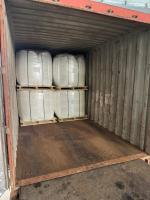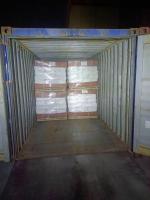Our Products
Polyacrylamide / Praesto; 2639 anionic polyacrylamide can be replaced by Chinafloc A2517

Main Application of Anionic Polyacrylamide (Praestol 2639): A Comprehensive 1001-Word Analysis
Anionic polyacrylamide (APAM), such as Praestol 2639, is a high-performance water-soluble polymer that is widely used across numerous industries for its flocculation, sedimentation, and water treatment properties. Praestol 2639, in particular, is a high molecular weight, anionic polyacrylamide that plays a vital role in solid-liquid separation processes. It is designed for use in various industries, including municipal and industrial wastewater treatment, mining, paper manufacturing, and oil and gas applications.
This document explores in detail the main application of anionic polyacrylamide Praestol 2639, focusing primarily on its role in municipal and industrial wastewater treatment, while also considering its ancillary uses in other sectors.
1. Overview of Anionic Polyacrylamide (Praestol 2639)
Praestol 2639 is an anionic flocculant supplied typically in powder or emulsion form. Its main characteristics include:
-
Anionic charge: Medium to high (usually 25–35%)
-
Molecular weight: Very high (above 10 million Daltons)
-
Physical form: Free-flowing white powder or milky emulsion
-
Solubility: Fully water-soluble
-
Polymer type: Linear or slightly branched copolymer of acrylamide and acrylic acid
Its anionic charge allows it to effectively interact with positively charged particles, colloids, and suspended solids typically present in wastewater.
2. Primary Application: Wastewater Treatment
The core application of Praestol 2639 lies in its use in wastewater treatment, particularly for solid-liquid separation. It acts as a flocculant to aggregate fine particles and colloids into larger flocs, which can then be removed via sedimentation, flotation, filtration, or centrifugation.
a. Municipal Wastewater Treatment
Municipal wastewater typically contains organic solids, sludge, and suspended particles from domestic sewage. Praestol 2639 is applied in:
-
Sludge dewatering: Enhances the water removal efficiency in belt filter presses, centrifuges, and screw presses.
-
Primary sedimentation tanks: Improves sedimentation of solids by flocculating suspended matter.
-
Secondary clarification: Assists in the removal of biological floc from activated sludge systems.
-
Tertiary treatment: Used in polishing processes to reduce turbidity and suspended solids.
Its high molecular weight and anionic charge density enable efficient bridging between particles, thereby producing dense, fast-settling flocs.
b. Industrial Wastewater Treatment
Industries such as textile, food and beverage, pulp and paper, mining, petrochemical, and metal processing all benefit from the use of Praestol 2639. It is used for:
-
Effluent clarification
-
Sludge thickening and dewatering
-
Color removal
-
Oil-water separation
In textile industries, for example, dye-laden effluent can be treated using Praestol 2639 to remove color and turbidity. In mining, it enhances the settling of tailings and recovers process water.
3. Mechanism of Action in Wastewater
The flocculation process involves:
-
Charge neutralization: The anionic polymer neutralizes the positive surface charges of suspended solids.
-
Bridging mechanism: Long polymer chains bridge multiple particles together, forming larger flocs.
-
Sedimentation: These large flocs settle more rapidly and compact more efficiently.
Praestol 2639 is especially efficient when dealing with high-suspended-solids or organic-rich sludge.
4. Advantages of Using Praestol 2639 in Water Treatment
-
Improved sludge dewatering: Results in drier cake, reducing disposal costs.
-
Faster sedimentation: Accelerates the clarification process.
-
Higher effluent quality: Reduces turbidity and total suspended solids (TSS).
-
Reduced polymer consumption: High efficiency allows lower dosage rates.
-
Operational stability: Performs reliably across a broad pH range (typically pH 4–9).
Its compatibility with other treatment chemicals, like coagulants (alum, ferric chloride), enhances its applicability.
5. Application Guidelines
a. Dosage
Typical dosages of Praestol 2639 range from 1 to 10 mg/L, depending on:
-
Suspended solids content
-
Wastewater type
-
pH and temperature
-
Presence of other chemicals
b. Preparation
When in powder form, it is dissolved in water (usually at 0.1–0.5% concentration) using appropriate mixing equipment. Emulsions may require inversion systems for activation.
c. Feeding Points
-
In sludge dewatering systems: Applied prior to centrifuges or filter presses.
-
In clarification tanks: Dosed at the inlet of the tank or after coagulation.
6. Other Applications Beyond Wastewater
Though wastewater treatment is the primary use, Praestol 2639 also has secondary applications in various sectors:
a. Mining and Mineral Processing
-
Tailings settling: Enhances the rate of sedimentation of fine tailings.
-
Thickener optimization: Increases underflow density and overflow clarity.
-
Process water recovery: Enables reuse of water in flotation circuits.
b. Paper Industry
Used in:
-
Paper machine white water treatment
-
Sludge management
-
Effluent clarification
It improves fiber recovery and reduces biological oxygen demand (BOD) of discharged water.
c. Agricultural and Soil Conditioning
Though less common, anionic polyacrylamides like Praestol 2639 are used to:
-
Prevent soil erosion
-
Improve water retention
-
Stabilize embankments and irrigation canals
These uses rely on the polymer’s ability to bind soil particles and enhance aggregate stability.
7. Environmental Considerations
Praestol 2639 is generally considered safe for use in water treatment applications, provided it is handled and dosed correctly. It has:
-
Low toxicity
-
Minimal residual monomer (acrylamide) levels—usually below 0.05%
-
No bioaccumulation
Nevertheless, overdosage can lead to polymer sludging or foaming. It is essential to optimize dosage via jar testing.
8. Storage and Handling
-
Store in dry, cool conditions away from direct sunlight.
-
Powder form is hygroscopic and should be sealed tightly.
-
Emulsions have a limited shelf life (6–12 months).
-
Use protective equipment when handling to avoid dust inhalation or skin contact.
9. Compatibility with Other Chemicals
Praestol 2639 is often used in combination with:
-
Inorganic coagulants (e.g., alum, PAC, FeCl₃)
-
Organic coagulants (e.g., polyamines, polyDADMAC)
-
pH control agents
The synergy of flocculants and coagulants can enhance particle aggregation and floc strength.
Conclusion
The main application of anionic polyacrylamide Praestol 2639 lies in wastewater treatment, specifically in flocculation and sludge dewatering processes. Whether in municipal plants handling domestic sewage or in industrial facilities treating process effluents, Praestol 2639 delivers high-performance results by effectively aggregating suspended solids, reducing turbidity, and enhancing water clarity. Its high molecular weight and suitable anionic charge make it ideal for a wide range of solid-liquid separation challenges. Beyond wastewater treatment, it also contributes to efficient operations in the mining, paper, and agricultural sectors. Proper application ensures environmental compliance, operational cost savings, and sustainable water management practices.



342_small.jpg)
317_small.jpg)
